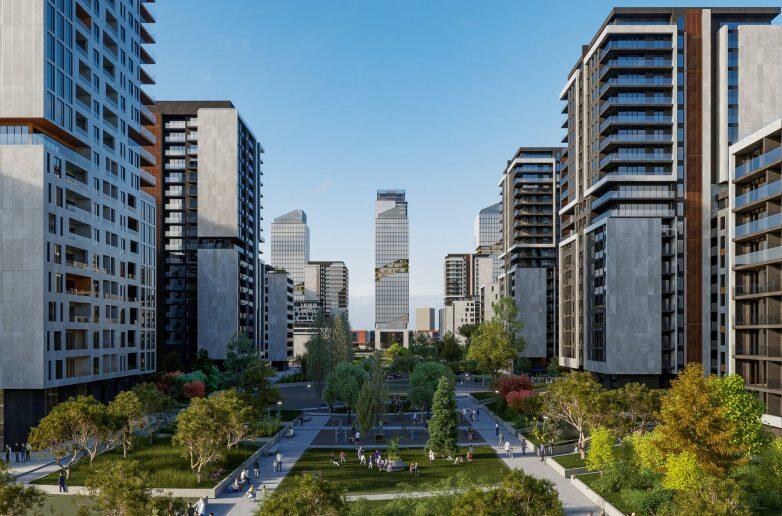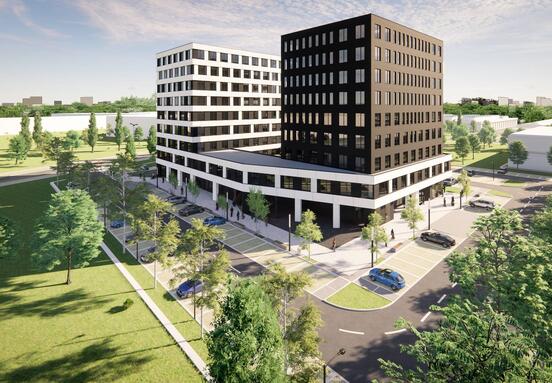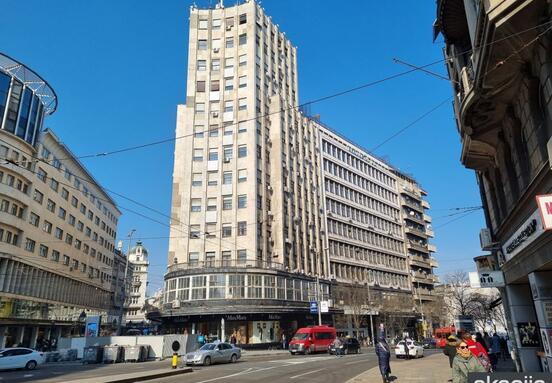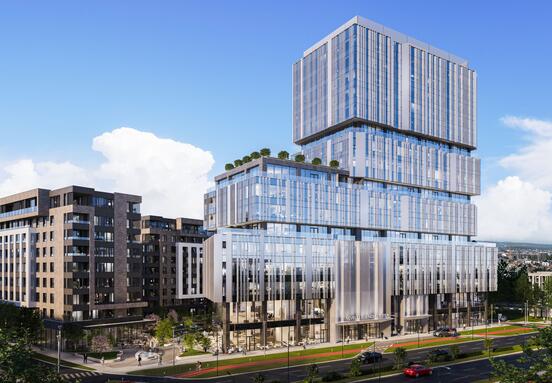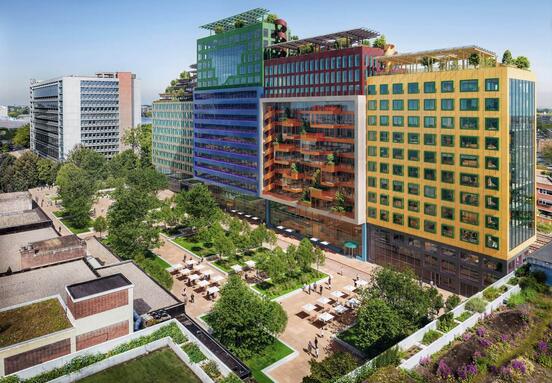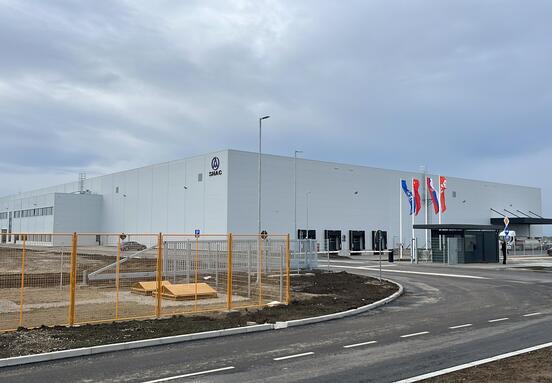When Le Corbusier's ideas from the Athens Charter began to be realized in Yugoslavia, his projects for a city of three million and other similar architectural and urban planning solutions became primary models for our architects.
Several generations of domestic architects grew up with geometric urban structures and vistas on drawings and models, where dominant positions were occupied by Cartesian office skyscrapers surrounded by multi-family residential settlements.
Unfortunately, these ideas were only partially developed in the area of New Belgrade blocks, where for several decades only residential structures were built, turning New Belgrade into a gigantic, contentless dormitory. Only in the early 2000s did a new stage begin in the development of the second urban core of our capital.
Architects began to break the architectural and urban monotony and introduce new content so that each micro-location could have as much potential as possible for self-sustaining living, business, and cultural-educational content. A block (Block 67a) and West 65 (Block 65) provided key guidelines for the further development and shaping of contemporary New Belgrade urbanism, recognized by their new residents.
From the Belgrade bureau ZAP, which brought forth the concept of A block, comes a new architectural and urban project that aims to materialize Le Corbusier's utopian ideas into aesthetic and functional reality.
Urban Analysis
The area of the former IMT factory is recognized in the Belgrade Master Plan and General Regulation Plan as the only remaining site for significant organized construction in the territory of New Belgrade, representing an exceptional spatial, functional, and investment resource for the city.
Work on the master plan for the IMT complex in Block 64 began at the initiative of the site owner, ABL Solvent d.o.o. from Belgrade, to assess the potential of the location, which covers cadastral parcel 2908 KO Novi Beograd, and an area of 35.8 hectares, and to define a preliminary urban-architectural solution whose results will be implemented in the detailed regulation plan.
According to the general regulation plan, most of the parcel space includes housing as the primary function, but also all other compatible functions that naturally complement housing – children's institutions, schools, health facilities, stores, and other smaller premises whose purpose corresponds to the primary housing function. Segments of the parcel facing Jurija Gagarina and Egipatska (formerly Zemunska) streets belong to the mixed-use city center zone, where high-rise business buildings are planned.
The authors of the urban solution are architects Jelena Stojkov and Bojan Zabukovec, while the authors of the architectural solution, in addition to the latter, are Nebojša Petković and Tamara Popović. They first decided to divide this large parcel into four independent units – blocks, which would function adequately with their various contents.
Thus, Block 1 covers about 11.4 ha, Block 2 about 7.2 ha, Block 3 about 3.5 ha, and Block 4 about 3.8 ha. To achieve the highest level of infrastructural functionality, it is planned to connect Jurija Gagarina and Egipatska streets with two new roads, provisionally named Nova 1 and Nova 2, while three smaller roads, named Nova 2a, Nova 3, and Nova 4, would also cut through the blocks.
The high traffic load of New Belgrade streets and the lack of parking spaces necessitated that the width of Nova 1 and 2 streets be between 31.5 and 34.5 meters, with two lanes, a bicycle lane, sidewalks, a green belt, and parking spaces, while Nova 3 and 4 streets would be about 23 meters wide, with double-sided parking zones, sidewalks, and a green belt.
In addition to street parking, underground garages for all residential and business buildings are also planned.
Primary Concept of the Green Line Project
Starting from a comprehensive view of the space, its development possibilities, the context of the residential environment, and the potential to improve the local ambiance and complete the silhouette of New Belgrade, a solution was formed that spatially, functionally, ecologically, and aesthetically connects the existing residential building character in the western part with the begun transformation of industrial complexes into commercial and residential contents in the eastern part of the location.
Not wanting to replicate the architecture of organized residential construction in Block 64, nor to repeat the organic, spontaneous form of the blocks on the eastern side of the complex, a solution of orderly organized superstructures with a pronounced organic form of greenery and surface landscaping is offered.
The "landmark" of the space is the green corridor, which stretches for 800 meters from Egipatska Street to Jurija Gagarina Street, with a varying width of 20 to 50 meters, ending in a zone of high-rise commercial buildings that will definitively enhance the silhouette of New Belgrade.
The concept consists of two rows of residential buildings meandering through Blocks 1 and 2, continuing the residential environment.
The positive side of this corridor is that it is initially conceived as a park unit, additionally enriched with children's playgrounds and sports fields, which was not the case with the landscaped structures of the old blocks from the 60s and 70s, which ended up as neglected meadows or seized construction land. The only shortcoming of the green corridor is its interruption at Nova 2a street, but this can be adequately resolved by building a simple pedestrian-bicycle overpass, allowing pedestrian and cyclist (often children) movement to flow seamlessly along the two residential blocks.
The concept consists of two rows of residential buildings meandering through Blocks 1 and 2, forming a continuation of the residential environment. The orientation of the residential buildings is northwest-southeast or southwest-northeast. The meandering housing concept was conceived by Le Corbusier, and our architects successfully implemented it in the early stages of New Belgrade's development.
However, this concept is now successfully elaborated under the conditions of private investment capital, which requires higher density, i.e., taller buildings, to better utilize the parcel's potential.
Narrower and taller buildings (up to 64 meters) are placed along the perimeter and the inner zone of the blocks, while longer and lower buildings (up to 32 meters) are positioned to form inner courtyards.
Architects decided to place narrower but taller buildings (up to 64 meters) along the perimeter and inner zone of the blocks to cast minimal shadow on other buildings. Longer but lower buildings (up to 32 meters) are positioned to form inner courtyards, serving as park micro-units interconnected by smaller passages. This rhythm of forms is well aligned with the recognizable architectural signature already achieved by the ZAP bureau in A block, the Lastavica complex, and the Square 43 complex.
The large parcel area and the higher number of residential units necessitated the inclusion of one elementary school within Block 1, one kindergarten within Block 2, and three smaller preschool institutions within the residential meanders, as additional capacities on the ground floors of the buildings. Also, within Block 2, a smaller building exclusively for cultural content is planned, with its final function to be determined later.
Business Towers as Visual Landmarks
Carefully designed urban structure, with roads and spatial dispositions, separates business Blocks 3 and 4 from residential areas. This separation ensures that both functions can operate smoothly without overlapping or interfering with each other.
This is crucial if, at the end of the entire complex, we have two separate units, Block 3 with three smaller business towers ranging from 112 to 120 meters in height, and Block 4, facing Jurija Gagarina Street, with the main business tower up to 160 meters high.
The traffic intensity and flow of people working in these business buildings dictate that they be clearly separated from residential areas, which have a completely different social structure and operational dynamics.
The position of the main business tower, facing Jurija Gagarina Street, its form and architecture, will position it as a new visual landmark of New Belgrade.
The urban-architectural structure of the business towers is quite unique, as there has not been an initiative from any domestic or foreign investor accompanied by an appropriate spatial-architectural solution comparable to this one.
The three smaller towers have a cubic form, contrasted by the curved form of the central tower. Both types of towers have facades with complex glass membranes, differently "cut" on each type, establishing a certain dynamism and playing with open and closed facade surfaces.
The position of the main business tower, facing Jurija Gagarina Street, its form and architecture, will position it as a new visual landmark of New Belgrade.
The proximity to other New Belgrade centers (about 1 to 3 km) and the old Belgrade core (about 5 km), along with the highly professionally designed urbanism, places this settlement at the top of prestigious residential and business locations. What was once viewed as the utopia of unfinished modernism has become the reality of contemporary architecture.
